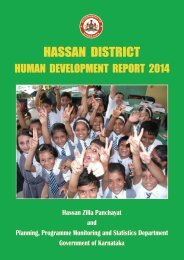Development
Raichur-DHDR-English-2014
Raichur-DHDR-English-2014
Create successful ePaper yourself
Turn your PDF publications into a flip-book with our unique Google optimized e-Paper software.
Status of Scheduled Castes and Scheduled Tribes<br />
is lower, but the proportion of small<br />
and marginal cultivators among SC<br />
and ST cultivators is also very huge<br />
(Figure 9.7).<br />
In this regard, NCEUS (2009)<br />
remarks that access to land is an<br />
important determinant of access to<br />
economic resources such as credit,<br />
as well as other resources that<br />
determine outcomes in terms of<br />
income. Further, the social identity<br />
of farmers is also seen to mediate<br />
access to economic resources and<br />
delivery of public services. Together,<br />
these factors account for lower<br />
levels of living of farmers in these<br />
groups, pointing to the need for<br />
concerted and multifaceted state<br />
policies and actions to ameliorate<br />
their disadvantages.<br />
Because of the smaller sized<br />
holdings, and preponderance of<br />
marginal sized holdings, SC and ST<br />
cultivators are unable to use<br />
modern methods of cultivation and<br />
get better access to market their<br />
produce. It is in this context that<br />
the government programs to<br />
improve productivity, profitability<br />
and sustainability among small<br />
land holders assume significance.<br />
Making small holders more<br />
competitive by enhancing their<br />
technical capacity and linking them<br />
effectively with market (which is<br />
currently absent) can be an effective<br />
way of improving livelihood of SC/<br />
ST households in rural areas. The<br />
strategy of exploring the<br />
possibilities of enhancing<br />
productivity can also be beneficial<br />
in addressing the problem of food<br />
insecurity.<br />
Figure 9.7: Agricultural Land Holdings across Social Groups in Raichur<br />
District (%)<br />
Source: DSO, Raichur, 2011-12<br />
9.5.3: Employment under<br />
MGNREGS<br />
MGNREGS aims to provide<br />
employment to unskilled workers<br />
in the vicinity of their residence at<br />
minimum wages, when demanded.<br />
Table 9.9 reveals a disturbing<br />
picture.<br />
Table 9.9: Participation in MGNREGS in Raichur District,<br />
2011-12<br />
Description SC ST<br />
% job cards issued to SC households 18.82 20.45<br />
% SC households worked 18.87 20.97<br />
% person-days worked by SCs 18.68 21.05<br />
Note: Percentages are to respective totals<br />
Source: www.nrega.in accessed on 2-4-2014<br />
Although the proportion of SC and<br />
ST households obtaining job cards<br />
almost corresponds to their<br />
population share, what matters is<br />
the percentage of them working<br />
under the scheme. Hardly 18.9 per<br />
cent of job card holders among SCs,<br />
and 21 per cent among STs worked<br />
under it. Their share in person days<br />
worked is also at same proportion.<br />
This only shows that, the<br />
203



